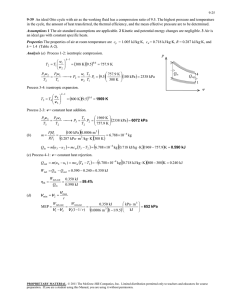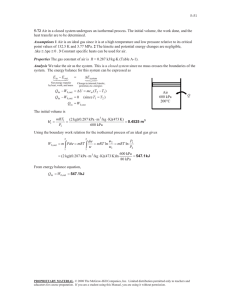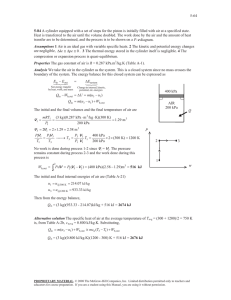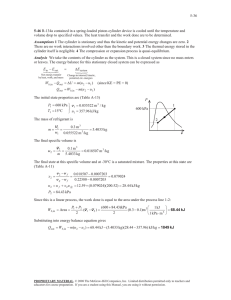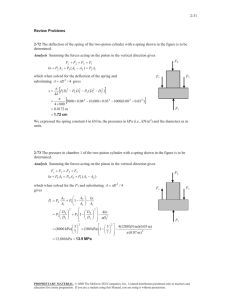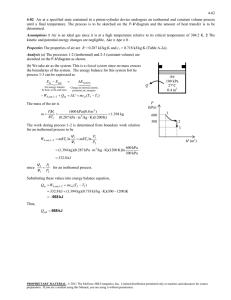Document 15326244
advertisement
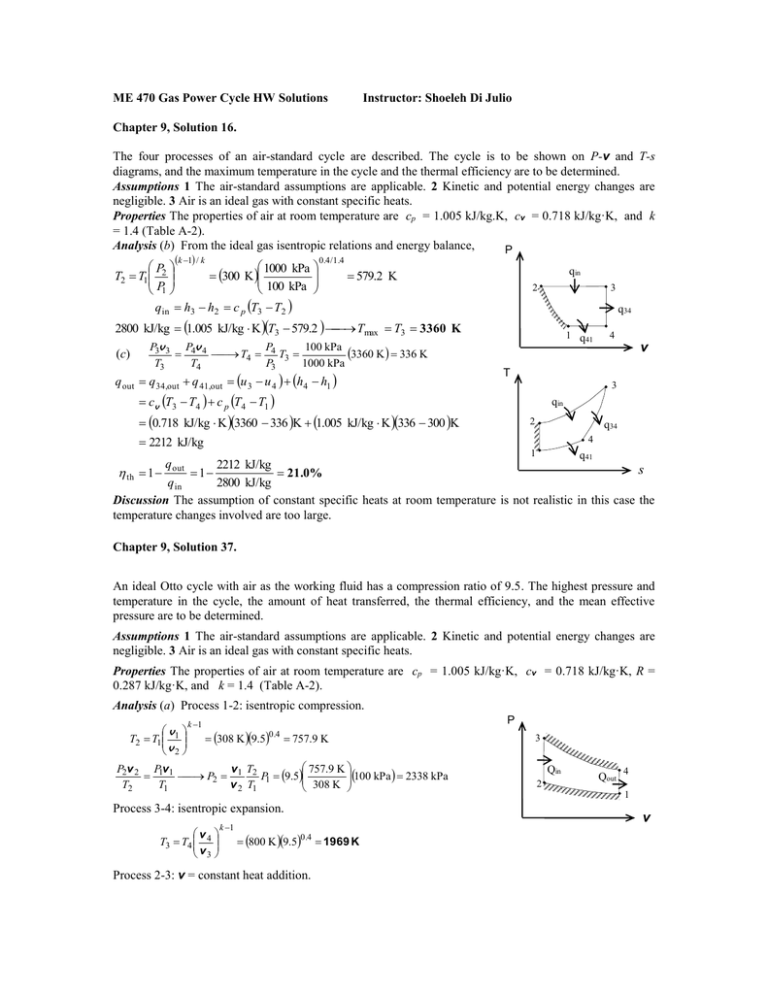
ME 470 Gas Power Cycle HW Solutions Instructor: Shoeleh Di Julio Chapter 9, Solution 16. The four processes of an air-standard cycle are described. The cycle is to be shown on P-v and T-s diagrams, and the maximum temperature in the cycle and the thermal efficiency are to be determined. Assumptions 1 The air-standard assumptions are applicable. 2 Kinetic and potential energy changes are negligible. 3 Air is an ideal gas with constant specific heats. Properties The properties of air at room temperature are cp = 1.005 kJ/kg.K, cv = 0.718 kJ/kg·K, and k = 1.4 (Table A-2). Analysis (b) From the ideal gas isentropic relations and energy balance, P k 1 / k P 1000 kPa T2 T1 2 300 K P 100 kPa 1 q in h3 h2 c p T3 T2 0.4/1.4 qin 579.2 K 3 2 q34 2800 kJ/kg 1.005 kJ/kg K T3 579.2 Tmax T3 3360 K (c) P3v 3 P4v 4 P 100 kPa 3360 K 336 K T4 4 T3 T3 T4 P3 1000 kPa q out q 34,out q 41,out u 3 u 4 h4 h1 1 q41 4 v T 3 cv T3 T4 c p T4 T1 qin 0.718 kJ/kg K 3360 336 K 1.005 kJ/kg K 336 300 K 2212 kJ/kg 2 q34 4 1 q41 q 2212 kJ/kg s th 1 out 1 21.0% q in 2800 kJ/kg Discussion The assumption of constant specific heats at room temperature is not realistic in this case the temperature changes involved are too large. Chapter 9, Solution 37. An ideal Otto cycle with air as the working fluid has a compression ratio of 9.5. The highest pressure and temperature in the cycle, the amount of heat transferred, the thermal efficiency, and the mean effective pressure are to be determined. Assumptions 1 The air-standard assumptions are applicable. 2 Kinetic and potential energy changes are negligible. 3 Air is an ideal gas with constant specific heats. Properties The properties of air at room temperature are cp = 1.005 kJ/kg·K, cv = 0.718 kJ/kg·K, R = 0.287 kJ/kg·K, and k = 1.4 (Table A-2). Analysis (a) Process 1-2: isentropic compression. v T2 T1 1 v2 k 1 P 308 K 9.5 0.4 757.9 K 757.9 K P2v 2 P1v1 v T 100 kPa 2338 kPa P2 1 2 P1 9.5 T2 T1 v 2 T1 308 K Process 3-4: isentropic expansion. v T3 T4 4 v3 k 1 800 K 9.50.4 1969 K Process 2-3: v = constant heat addition. 3 Qin 2 Qout 4 1 v v 1969 K P3v 3 P2v 2 T 2338 kPa 6072 kPa P3 3 P2 T3 T2 T2 757.9 K (b) m P1V1 100 kPa 0.0006 m3 6.788 10 4 kg RT1 0.287 kPa m 3 /kg K 308 K Qin mu3 u 2 mcv T3 T2 6.78810 4 kg 0.718 kJ/kg K1969 757.9K 0.590 kJ (c) Process 4-1: v = constant heat rejection. Qout m(u 4 u1 ) mcv T4 T1 6.78810 4 kg 0.718 kJ/kg K800 308K 0.240 kJ Wnet Qin Qout 0.590 0.240 0.350 kJ th (d) Wnet,out Vmin V2 MEP Qin 0.350 kJ 59.4% 0.590 kJ Vmax r Wnet,out V1 V2 Wnet,out V1 (1 1 / r ) kPa m 3 652 kPa 0.0006 m 1 1/9.5 kJ 0.350 kJ 3 Chapter 9, Solution 65. An ideal steady-flow Ericsson engine with air as the working fluid is considered. The maximum pressure in the cycle, the net work output, and the thermal efficiency of the cycle are to be determined. Assumptions Air is an ideal gas. Properties The gas constant of air is R = 0.287 kJ/kg.K (Table A-1). Analysis (a) The entropy change during process 3-4 is s 4 s3 q 34,out T0 s 4 s 3 c p ln and T4 T3 150 kJ/kg 0.5 kJ/kg K 300 K 0 Rln P4 P3 T 300 K P4 0.287 kJ/kg K ln 0.5 kJ/kg K 120 kPa It yields qin 4 3 q out TL T 1200 K 150 kJ/kg 600 kJ/kg q in H q out q in TH TL 300 K wnet,out q in q out 600 150 450 kJ/kg (c) The thermal efficiency of this totally reversible cycle is determined from th 1 TL 300 K 1 75.0% TH 1200 K 2 qout P4 = 685.2 kPa (b) For reversible cycles, Thus, 1 1200 K s Chapter 9, Solution 66. An ideal Stirling engine with helium as the working fluid operates between the specified temperature and pressure limits. The thermal efficiency of the cycle, the amount of heat transfer in the regenerator, and the work output per cycle are to be determined. Assumptions Helium is an ideal gas with constant specific heats. Properties The gas constant and the specific heat of helium at room temperature are R = 2.0769 kJ/kg.K, cv = 3.1156 kJ/kg.K and cp = 5.1926 kJ/kg.K (Table A-2). Analysis (a) The thermal efficiency of this totally reversible cycle is determined from th 1 TL 300 K 1 85.0% TH 2000 K (b) The amount of heat transferred in the regenerator is Qregen Q41,in mu1 u4 mcv T1 T4 T 1 2000 K qin 2 0.12 kg 3.1156 kJ/kg K 2000 300 K 635.6 kJ 300 K P3v 3 P1v 1 v T P 300 K 3000 kPa v 3 3 1 3 2 T3 T1 v 1 T1 P3 2000 K 150 kPa v1 T2 T1 3 qout (c) The net work output is determined from s2 s1 cv ln 4 0 Rln v2 2.0769 kJ/kg K ln 3 2.282 kJ/kg K v1 Qin mTH s2 s1 0.12 kg 2000 K 2.282 kJ/kg K 547.6 kJ Wnet,out th Qin 0.85 547 .6 kJ 465.5 kJ s
